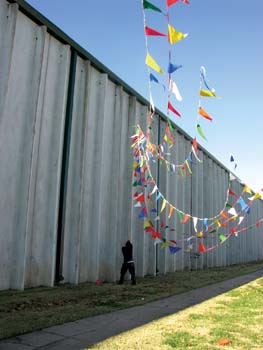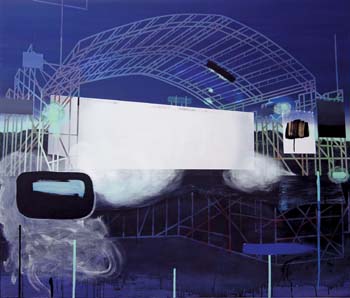
Point.” The WSU assistant professor of painting
and drawing was born in Hungary and considered
a career as an architect. His “Rehearsal” (2010),
an acrylic on canvas, is shown below.
Levente Sulyok, WSU assistant professor of painting and drawing, was born in Hungary, where he was raised in the twilight years of communism.
Uniforms were compulsory at his school and his long hair raised more than a few eyebrows, but he recalls that his home life was anything but restrictive.
“It was like an island created by my somewhat strange and definitely idiosyncratic but very passionate father,” he says. “That translates into my work: I think about the studio as a zone that doesn’t have predetermined codes, a place where you can act as a free agent.”
The family lived an isolated lifestyle, their house nestled on a desolate, unpaved road where they had limited access to running water and electricity.
Yet his father managed to avail himself with accoutrements that belied the otherwise primitive existence. The family had a 1927 Indian motorcycle and a 1968 Chevy Impala that was procured from a family friend who worked at a Budapest garage where well-placed members of the Communist Party kept their vehicles.
“There was equality,” Sulyok says, “unless you were a member of the Party. It was surreal.”
He began drawing pictures around the same time he started speaking and, in his younger years, was able to attend art camps. Early on, he became enamored of Jackson Pollock’s work. “It was very individualistic,” he says. “It was expressive, about finding your niche, your own style and I was prone to that way of thinking already. I jumped right in.”
Although his parents were not well-educated, Sulyok says they provided him with a fascinating intellectual climate at home, dabbling in art and other pursuits and amassing a legacy of the unconventional. But his father died when Sulyok was barely into his teens; when his mother remarried a few years later, the family moved to the United States, landing in northern California.
Despite struggling to learn English, by his late 20s he’d earned a bachelor’s degree in art from the University of California at Berkley and set his sights on graduate programs in painting, eventually attending the Rhode Island School of Design.

During his studies, he contemplated a career as an architect but realized that his apprenticeship in that discipline might prove more laborious and prolonged than one as a painter; he fell back to his first passion and was determined to become an art educator.
Colleagues in Rhode Island suggested that he set New York or Chicago as his professional destination; he instead offered an unexpected place. “It’s a true story,” he says with a laugh. “I said, ‘What about Wichita?’ ” He knew almost nothing of the city but found the landscape appealing for several reasons, not least of which was that he saw a connection between it and his home in Hungary.
While his locales have changed, his artistic interests have remained the same. The influence of architecture, with its attention to systems and order, for instance, is seen in “Fountain” (2010), “Rehearsal” (2009) and “Accidental Structure” (2008). His 2004 “Wall Drawing” illustrates his awareness of, among other things, the sometimes cold and distanced nature of architecture itself. Created with the use of architectural templates, “Wall Drawing” highlights what he sees as the “inexpressive, calculated and factual” elements of architecture, as well as its tendency to become “completely abstract.”
Elsewhere, construction tools, electric mechanisms and cement blocks figure heavily in “Studio Monolith” (2005) and “Performance” (2005), while “Sisyphus” (2006) offers a glimpse of the place where the accidental and the intentional intersect with the artist’s mind and hand and the world from which he collects or happens upon his raw materials.
“It’s that idea of manipulating space,” he says, “for whatever purpose you choose: political, cultural and experiential. Architecture may be the highest form of art because of that. You step inside a cathedral and because of how it was designed, you have a certain emotional response. It’s a great way to express very complicated human desires and thoughts.”
As conscious of artistic tradition as of contemporary art and theory, he notes that the influence of the place from which an artist emerges or where he makes his work is difficult to assess. “I live here and, yes, I was born in Hungary,” he says, “but if I had a show there today it would be difficult to look at my work and find something particularly Hungarian about it.” In short, his work seems to issue more from the times — the post-globalization age — than any particular place.
That notion is advanced by his artist statement: “My current body of work utilizes signifiers from contemporary everyday life such as scaffoldings, outdoor advertising structures and various tools of commerce in relationship to modern and contemporary visual and conceptual conventions. Through such investigations, I aim to highlight the relationship between art, advertisement and an increasingly globalized consumer culture, as well as the ways in which these phenomena relate to the cultural ideologies of specific ‘places.’ By careful planning and playful execution, I aim to connect philosophical thought and contemporary theory with images from the built environment that defines urban life.”
“I’m interested in asking questions about categories and how meaning is created,” he says. “While in the act of making, painting becomes a kind of theater where painting or the failure of painting is staged, and it becomes a way for me to suspend the regularity of the rest of the world. But once the painting is released into the world, it also becomes codified language that hopefully communicates its content successfully.”
Sulyok’s art suggests that the “free-zone” island first created by his father all those years ago on a desolate road in Hungary has survived into our shifting, restless world. It is an island where boundaries disappear, where the idiosyncratic becomes the norm and where the concrete and the abstract exchange shapes and inspire us to contemplate them both — and their futures.





